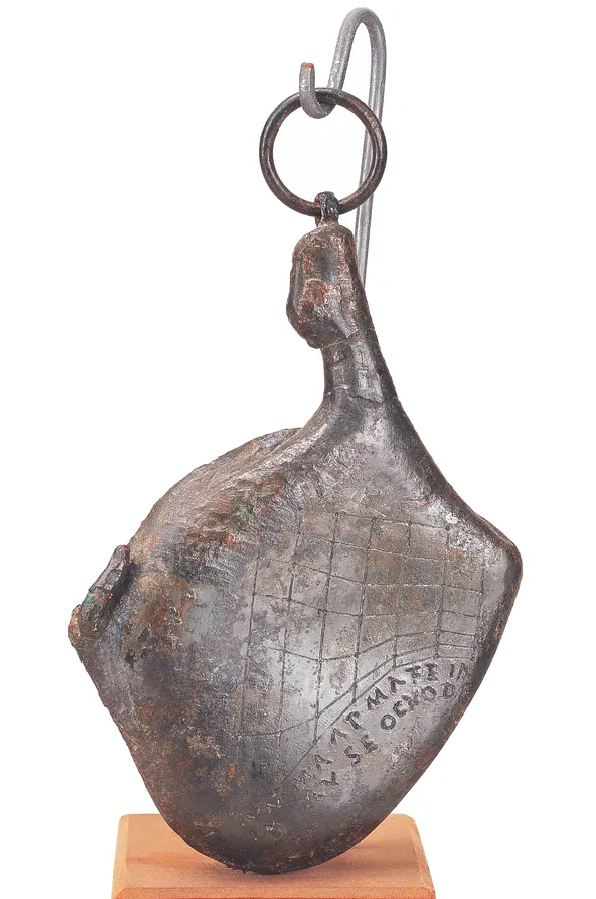What's New Under The Sun
Madison Historic Dial Returns
Monday, 13 October 2025 22:49
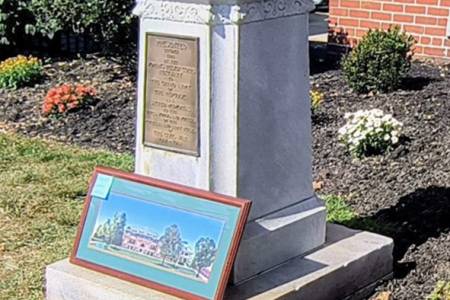 On October 4, 2025 Madison Historical Society of Ohio was able to have their sundial returned after 32 years, when in 1993 it was moved to the lawn of Lake County Courthouse to reduce the chance of vandalism. The sundial was originally placed at Madison Home 100 years ago on Saturday, October 24, 1925 during a conference of the Women's Relief Society. From 1904 to 1962 the state ran this...
On October 4, 2025 Madison Historical Society of Ohio was able to have their sundial returned after 32 years, when in 1993 it was moved to the lawn of Lake County Courthouse to reduce the chance of vandalism. The sundial was originally placed at Madison Home 100 years ago on Saturday, October 24, 1925 during a conference of the Women's Relief Society. From 1904 to 1962 the state ran this...
Elements of Dialing Course - 2025
Monday, 15 September 2025 19:42
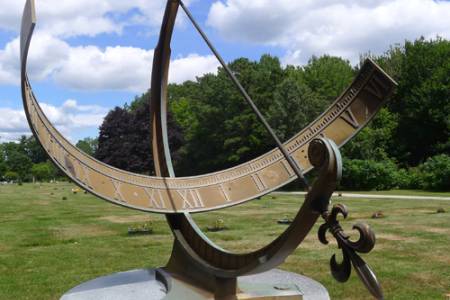 NASS is pleased to announce the upcoming fifth instance of Elements of Dialing, our introductory course about sundials, their history, and the science that makes them work. The free 12-lesson course, intended for those are new to sundialing, runs from 27 October 2025 until 26 April 2026. The course instructor is Robert Kellogg, NASS Vice President and Sundial Registrar. Bob will be...
NASS is pleased to announce the upcoming fifth instance of Elements of Dialing, our introductory course about sundials, their history, and the science that makes them work. The free 12-lesson course, intended for those are new to sundialing, runs from 27 October 2025 until 26 April 2026. The course instructor is Robert Kellogg, NASS Vice President and Sundial Registrar. Bob will be...
Sun Queen of World War II
Thursday, 11 September 2025 23:11
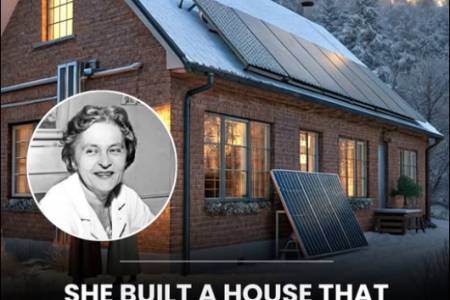 A Hungarian born American scientist, Mária Telkes (1900-1995), was called "The Sun Queen" and among other honors, was postmousthly inducted into the National Inventors Hall of Fame. She lived to 95 and for most of her life developed solar power in a variety of forms.
Trained as a biophysicist, she worked for Westinghouse Electrical and Manufacturing Company in Pittsburgh, PA, where she...
A Hungarian born American scientist, Mária Telkes (1900-1995), was called "The Sun Queen" and among other honors, was postmousthly inducted into the National Inventors Hall of Fame. She lived to 95 and for most of her life developed solar power in a variety of forms.
Trained as a biophysicist, she worked for Westinghouse Electrical and Manufacturing Company in Pittsburgh, PA, where she...
2025 Conference -Ottawa
Thursday, 28 August 2025 23:25
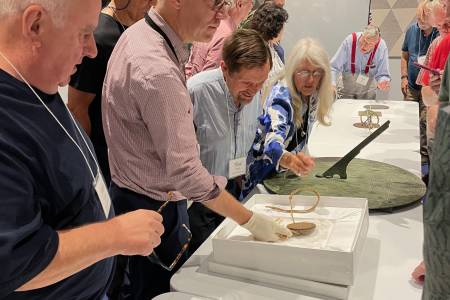 The annual NASS Conference was held 7-10 August, 2025 in Ottawa. As usual, the conference began late Thursday afternoon with an introduction social and a "grab bag give away", taking your chances with tickets to win the bag's prize. Will Grant was the final winner of the Walton Double Planar Polar Sundial, but Paul Ulbrich beat the statistic odds and won this prize three times,...
The annual NASS Conference was held 7-10 August, 2025 in Ottawa. As usual, the conference began late Thursday afternoon with an introduction social and a "grab bag give away", taking your chances with tickets to win the bag's prize. Will Grant was the final winner of the Walton Double Planar Polar Sundial, but Paul Ulbrich beat the statistic odds and won this prize three times,...
Prosciutto di Portici Sundial's Owner
Tuesday, 10 June 2025 18:51
 Prosciutto di Portici (Ham) Sundial
Photo: Getty Images
The Prosciutto di Portici Sundial, more often called the Portici Ham Sundial, dates from the first century somewhere between 8 BCE to 79 CE. This small silvered bronze dial was uncovered on 11 June, 1755 in the ruins of Herculaneum (current day Portici) in the "Villa of the Papyri", buried in...
Prosciutto di Portici (Ham) Sundial
Photo: Getty Images
The Prosciutto di Portici Sundial, more often called the Portici Ham Sundial, dates from the first century somewhere between 8 BCE to 79 CE. This small silvered bronze dial was uncovered on 11 June, 1755 in the ruins of Herculaneum (current day Portici) in the "Villa of the Papyri", buried in...
Hamilton Dial Dedicated
Friday, 06 June 2025 21:01
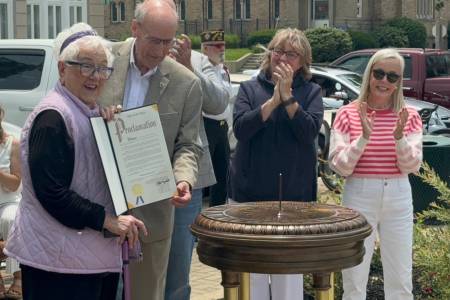 Sundial dedication May 31, 2025. At left is Kathleen Stuckey Fox, with the City Proclamation presented by Mayor Pat Moeller and City Council on-lookers Carla Fiehrer and Susan Vaughn offering congratulations.
On May 31, 2025 at 1pm, the Hamilton, Ohio, sundial (NASS Sundial Registry #1109) was re-dedicated in Monument Park. Originally dedicated in 1941 to the...
Sundial dedication May 31, 2025. At left is Kathleen Stuckey Fox, with the City Proclamation presented by Mayor Pat Moeller and City Council on-lookers Carla Fiehrer and Susan Vaughn offering congratulations.
On May 31, 2025 at 1pm, the Hamilton, Ohio, sundial (NASS Sundial Registry #1109) was re-dedicated in Monument Park. Originally dedicated in 1941 to the...
Frans Maes Received a Royal Decoration
Monday, 24 March 2025 21:33
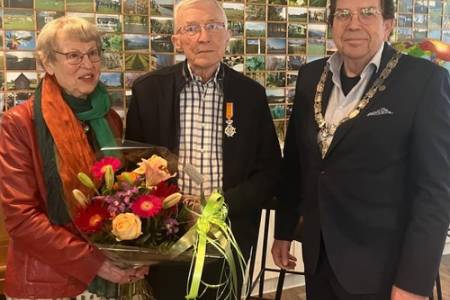 Several years ago Frans decided to write the course on sundials that included self assessment questions to force students not only to read the text, but to internalize the concepts. And a final submittal question "not necessarily a difficult question, but: no answer, no new lesson." Thus Frans Maes began writing lessons and sending them out to students.
NASS has now used his material to create...
Several years ago Frans decided to write the course on sundials that included self assessment questions to force students not only to read the text, but to internalize the concepts. And a final submittal question "not necessarily a difficult question, but: no answer, no new lesson." Thus Frans Maes began writing lessons and sending them out to students.
NASS has now used his material to create...
Pros and Cons of Daylight Savings Time
Monday, 24 March 2025 15:37
 In a 24 March 2025 article from the on-line Science Advisor (American Association for the Advancement of Science) Phie Jacobs summarizes the "great debate" of the yearly shift from standard time to daylight savings time. In January 2025 the US Senate introduced the Sunshine Protection Act to permanently have daylight savings time year round. Certainly 54% of Americans do not like the...
In a 24 March 2025 article from the on-line Science Advisor (American Association for the Advancement of Science) Phie Jacobs summarizes the "great debate" of the yearly shift from standard time to daylight savings time. In January 2025 the US Senate introduced the Sunshine Protection Act to permanently have daylight savings time year round. Certainly 54% of Americans do not like the...
Native American Moon Alignment Ring
Friday, 21 March 2025 19:26
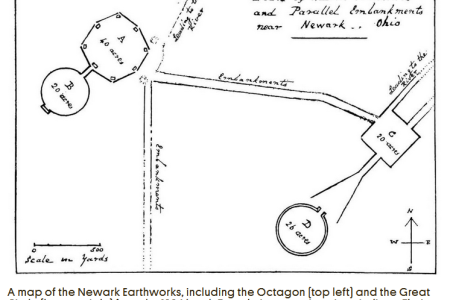 Perhaps the most famous alignment circle in the United States is the Cahokia Woodhenge near St. Louis constructed between 700-1400 CE by Cahokia Indigenous native Americans. But there were an estimated 10,000 other earthen mounds that once were scatter across the mid-west..
In an article from Atlas Obscura (https://www.atlasobscura.com/articles/octagon-earthworks-ohio) by Olivia Young on March...
Perhaps the most famous alignment circle in the United States is the Cahokia Woodhenge near St. Louis constructed between 700-1400 CE by Cahokia Indigenous native Americans. But there were an estimated 10,000 other earthen mounds that once were scatter across the mid-west..
In an article from Atlas Obscura (https://www.atlasobscura.com/articles/octagon-earthworks-ohio) by Olivia Young on March...
Hamilton Dial under Restoration
Friday, 21 March 2025 18:37
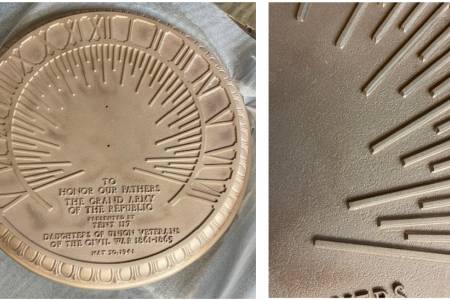 The Hamilton dial is in the restorative care of Jarrett and Celene Hawkins (Hawkins & Hawkins Custom, LLC in Cincinnati Ohio https://www.studio-hawkins.com/) in preparation for the dial's dedication on Saturday, May 31, 2025.
The face of the Hamilton Grand Army of the Republic (GAR) sundial has been cleaned and bead-blasted showing the dial as it was cast 84 years ago. In the process,...
The Hamilton dial is in the restorative care of Jarrett and Celene Hawkins (Hawkins & Hawkins Custom, LLC in Cincinnati Ohio https://www.studio-hawkins.com/) in preparation for the dial's dedication on Saturday, May 31, 2025.
The face of the Hamilton Grand Army of the Republic (GAR) sundial has been cleaned and bead-blasted showing the dial as it was cast 84 years ago. In the process,...
VSSC Space Museum gets Polar Sundial
Tuesday, 17 December 2024 23:47
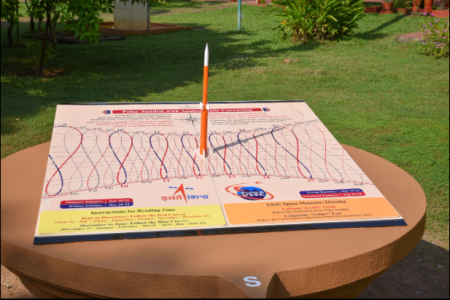 In November 2024, a team consisting of members from SPL, TTDG and CMD of VSSC successfully designed and installed an accurate and fully functional sundial at the Rocket Garden of VSSC Space Museum, Thumba (8.53°N, 76.86°E). Following a space theme, the vertical gnomon is a 3-stage rocket that casts its daily and seasonal shadow on a dial face 1 1/2 meters by 1 meter. The the sundial face...
In November 2024, a team consisting of members from SPL, TTDG and CMD of VSSC successfully designed and installed an accurate and fully functional sundial at the Rocket Garden of VSSC Space Museum, Thumba (8.53°N, 76.86°E). Following a space theme, the vertical gnomon is a 3-stage rocket that casts its daily and seasonal shadow on a dial face 1 1/2 meters by 1 meter. The the sundial face...
Historic Sundials of Andalusia
Saturday, 16 November 2024 00:07
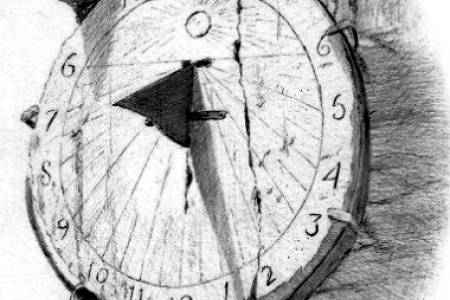 Esteban Martínez Almirón has published a new book Historical Sundials: Forgotten Andalusian Treasures (Relojes de Sol Históricos Tesoros Andaluces Olvidados) In it he reviews over 400 sundials from the Andalucian region of southern Spain Originally to celebrate the 25th year of the website https://relojandalusi.org/
Esteban Martínez Almirón began showing his sundial drawings on the site....
Esteban Martínez Almirón has published a new book Historical Sundials: Forgotten Andalusian Treasures (Relojes de Sol Históricos Tesoros Andaluces Olvidados) In it he reviews over 400 sundials from the Andalucian region of southern Spain Originally to celebrate the 25th year of the website https://relojandalusi.org/
Esteban Martínez Almirón began showing his sundial drawings on the site....
Gardom's Edge Monolith
- Details
- Hits: 16442
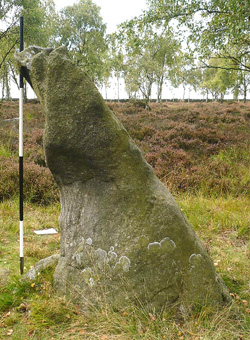
Gardom Edge Monolith
[photo courtesy of Dan Brown, Nottingham Trent University]
|
A two meter standing stone at Gardom’s Edge may be an astronomically aligned monolith set up during the Neolithic period 2,500 – 1,500 BCE to recognize the summer solstice. According to Dan Brown, Andy Alder and Elizabeth Bemand of Nottingham Trent University, “Such an astronomically aligned stone could be described as a seasonal sundial … However it is not intending to mark local time during a day or measure exact dates during a year. Rather the seasonal shadow casting allows for the display of cosmological knowledge such as the ‘death’ and ‘rebirth’ of the Sun”…
The upward facing north slope of the stone remains in shadow until near the time of Summer solstice. Today the stone points south at an upward tilt of 58.3° +/- 2.9°, seemingly aimed at the highest rise of the summer sun, computed for the Gardom Edge latitude of 53.26° as 60.7° in Neolithic times.
Pantheon Sundial
- Details
- Hits: 26986
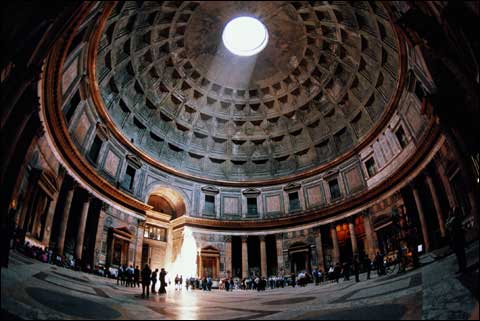
One of the most iconic buildings in the world, the Pantheon in Rome is an enduring testament to the power and glory of ancient Rome. At the same time, it has also always posed something of a mystery. The only source of natural lighting is a thirty-foot diameter hole at the very top of the hemispherical dome, often referred to as the "oculus".
Working since 2009, scholars Guilio Magli and Robert Hannah discovered that at midday on the equinoxes, a shaft of circular light shines through the oculus and illuminates the Pantheon's entrance.
Early Astronomers
- Details
- Hits: 16206
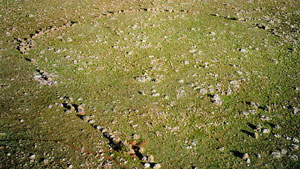 [photo credit: Andrew Caswell and
Robert Cockburn of The Daily Telegraph ]
|
Ask a person what is the earliest evidence of humans building structures to mark significant celestial events, and one offer "Stonehenge". But there may be a structure built thousands of years early according to some experts in Australia.
A site "down under", name Wurdi Youang, estimated to be older than 10,000 years, has a strange arrangement of stones with alignments toward solstices and equinox that has been scrutinized by several eminent Australian scientists. They conclude that the placement and alignment of the stones is not an accident and there is a perfect alignment with the setting sun on the mid-summer day. Understandably, the exact location of the site is a well-guarded secret, but it is known to be west of Melbourne approximately 80 kilometers.
Madison Historic Dial Returns
- Details
- Hits: 651
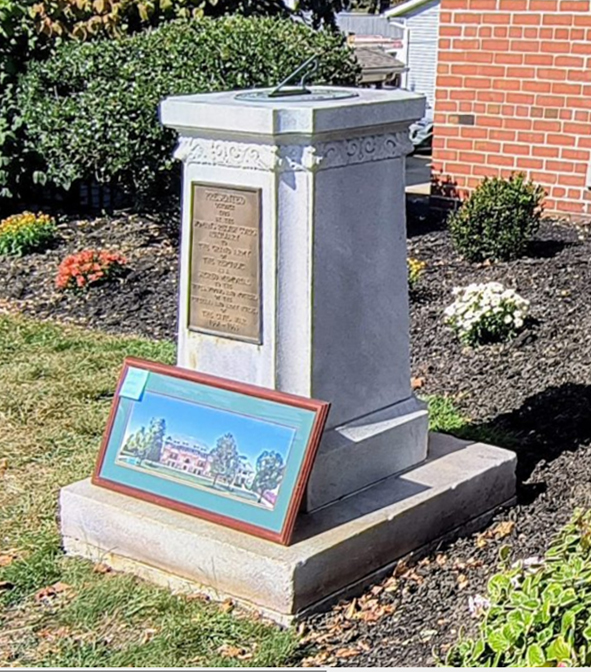 On October 4, 2025 Madison Historical Society of Ohio was able to have their sundial returned after 32 years, when in 1993 it was moved to the lawn of Lake County Courthouse to reduce the chance of vandalism. The sundial was originally placed at Madison Home 100 years ago on Saturday, October 24, 1925 during a conference of the Women's Relief Society. From 1904 to 1962 the state ran this building as it was run since 1889, for the needy widows, mothers and children of Ohio’s veterans. They named this building the Madison Home.
On October 4, 2025 Madison Historical Society of Ohio was able to have their sundial returned after 32 years, when in 1993 it was moved to the lawn of Lake County Courthouse to reduce the chance of vandalism. The sundial was originally placed at Madison Home 100 years ago on Saturday, October 24, 1925 during a conference of the Women's Relief Society. From 1904 to 1962 the state ran this building as it was run since 1889, for the needy widows, mothers and children of Ohio’s veterans. They named this building the Madison Home.
Cheryl Swackhammer, president of the Madison Historical Society, opened the rededication ceremony and thanked everyone who had made the sundial's move back to Madison possible. The return of the dial was spearheaded by Kenneth Gauntner, a former Madison Township trustee's and Lake County administrator.
The circular bronze dial with open gnomon sits on a tapered pedestal 3ft (1m) high with a bonze plaque on the pedestal recording the dedication for the Women Relief Society 100 years ago.
Read the article by gmcvey in the Gazette On-Line News at https://gazettenews.com/sundial-monument-rededicated-at-madison-historical-society/
Prosciutto di Portici Sundial's Owner
- Details
- Hits: 2572
|
Prosciutto di Portici (Ham) Sundial
Photo: Getty Images
|
The Prosciutto di Portici Sundial, more often called the Portici Ham Sundial, dates from the first century somewhere between 8 BCE to 79 CE. This small silvered bronze dial was uncovered on 11 June, 1755 in the ruins of Herculaneum (current day Portici) in the "Villa of the Papyri", buried in volcanic ash and charred papyri from the eruption of Mount Vesuvius in 79 CE. The form of the sundial, which resembles a ham, has been extensively studied. It is an altitude dial with similarities to the cylindrical sundial.
Live Science reporter Kristina Killgrove writes, "Historians have long assumed that the owner of the Villa of the Papyri was L. Calpurnius Piso Caesoninus, the father-in-law of Julius Caesar." https://www.livescience.com/archaeology/romans/prosciutto-di-portici-a-portable-sundial-that-looks-like-a-pork-leg-and-it-was-likely-owned-by-julius-caesars-father-in-law-before-mount-vesuvius-erupted
Calpurnius likely commissioned the Epicurean philospher Philodemus to drave the numerous charred scrolls at Villa of the Papyri. Killgrove commented that "This may explain why the Roman pocketwatch was shaped like a ham. For adherents of Epicurean thought, the lowly pig was often used as a metaphor, as it was seen as a naturally pleasure-seeking creature.
To clarify the use of the dial and the drawn lines attributed in the article as "hours before or after sunset" were actually temporal hours. The lines measuried the hours from sunrise to sunset. Temporary (ancient) hours go across the dial face and vertical lines represent the boundary between the zodiac signs representing the twelve months of the year. In this dial the twelve months have been “folded” and the month pair labeled between the lines: IUN-IU (June-July), MA-AU (May-August), AP-SE (April-September), MA-OC (March-October), FE-NO (February-November) and JA-DE (January-December). Notice that both July and August are used and the longest shadows occuring at the end of June while the shortest occur at the end of December. Further, since July and August are named, the dial was created after the reign of Julius and Augustus Caesar, and in particular when Augustus renamed the month Sextilis to August in 8 BCE.
The Ham dial has a fixed gnomon, the flattened piece at middle-left in the photo. When properly working, the gnomon is actually much longer and the tip set a specific distance above the dial face and at the upper left corner of the hour-date lines. To read the time, the dial is rotated from a string at top of the dial until the shadow falls on the vertical date line (or distance between) corresponding to the date. Like the cylindrical sundial, time is read from the downward shadow of the tip crossing the temporary hour line.
The Ham dial also has “folded” hour lines that run across the dial to tell temporary (ancient) hours. The lines are from top to bottom are for sunrise, 1st/11th, 2nd/10th, 3rd/9th, 4th/8th, 5th/7th, and at bottom, the 6th hour line for mid-day.
Historic Sundials of Andalusia
- Details
- Hits: 3890
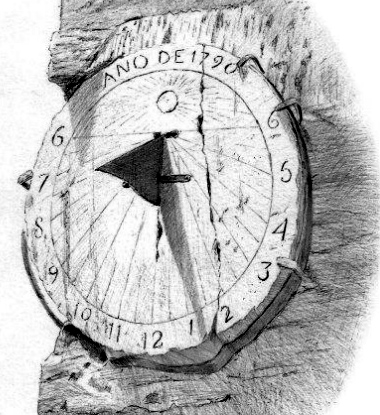 Esteban Martínez Almirón has published a new book Historical Sundials: Forgotten Andalusian Treasures (Relojes de Sol Históricos Tesoros Andaluces Olvidados) In it he reviews over 400 sundials from the Andalucian region of southern Spain Originally to celebrate the 25th year of the website https://relojandalusi.org/
Esteban Martínez Almirón has published a new book Historical Sundials: Forgotten Andalusian Treasures (Relojes de Sol Históricos Tesoros Andaluces Olvidados) In it he reviews over 400 sundials from the Andalucian region of southern Spain Originally to celebrate the 25th year of the website https://relojandalusi.org/
Esteban Martínez Almirón began showing his sundial drawings on the site. Ultimately more than 60 drawings are in his book, and many are posted on the @stbnart Instagram site. He presents the historical sundials using the themes according to geographical location and building type (e.g. on farms or country houses for daily time telling; churches, cathedrals and other sanctuaries; and civil buildings and public places). Unfortunately many dials have been lost to history and no longer exist.
Martínez Almirón looks briefly at portable sundials of Andalusia, particularly in Sierra de Huelva, the city of Ubeda (where its Renaissance sundials stand out) and the dials of the "New Populations" ("Nuevas Poblaciones"). The book is self-published. If you are interested in purchasing a copy, you can visit https://relojandalusi.org/relojes-de-sol-historicos/. The book cost is 12 euros plus shipping. Text in Spanish.
Rare Astrolabe Discovered by Chance in Verona Museum
- Details
- Hits: 5784
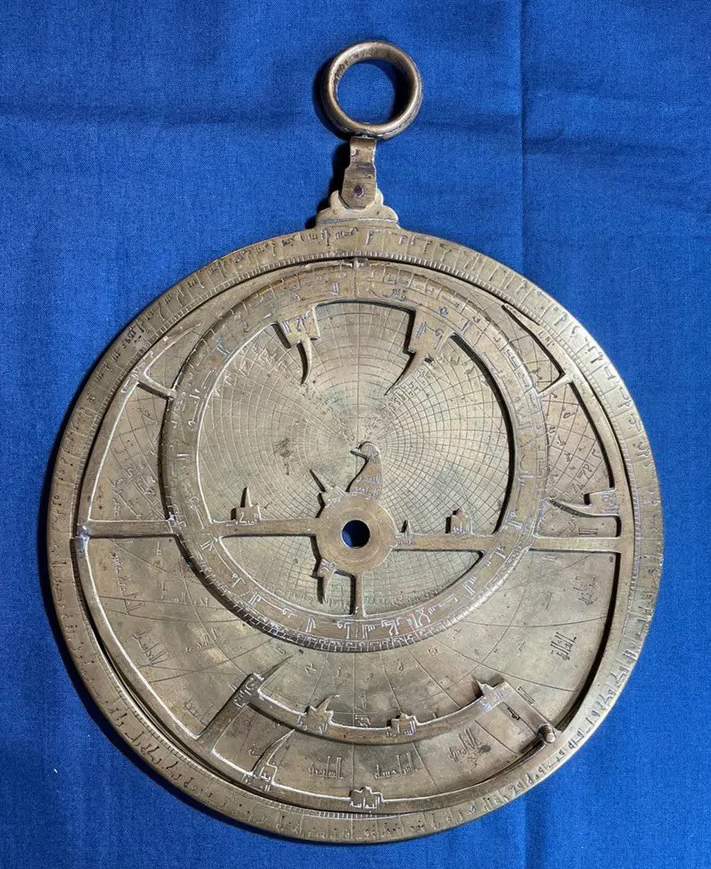 Dr. Federica Gigante, from Cambridge Univerity's History Faculty, discovered a rare astrolabe sequestered in a museum at Verona, Italy. Publishing in Nuncius (1 March 2024) Dr. Gigante presents "a hitherto unknown remarkable astrolabe from Al-Andalus which likely belonged to the collection of Ludovico Moscardo (1611–1681) assembled in Verona in the seventeenth century. The astrolabe is datable to the eleventh century and features added Hebrew and Latin inscriptions. It underwent many modifications, additions, and adaptations as it changed hands and owners over time thus becoming a palimpsest object. With its added translations from Arabic into Hebrew, the astrolabe closely recalls the recommendations prescribed by the Spanish Jewish polymath Abraham Ibn Ezra (1089–1167) in the earliest surviving treatise on the astrolabe in the Hebrew language written in 1146 precisely in Verona." Today the astrolabe is preserved at the Fondazione Museo Miniscalchi-Erizzo.
Dr. Federica Gigante, from Cambridge Univerity's History Faculty, discovered a rare astrolabe sequestered in a museum at Verona, Italy. Publishing in Nuncius (1 March 2024) Dr. Gigante presents "a hitherto unknown remarkable astrolabe from Al-Andalus which likely belonged to the collection of Ludovico Moscardo (1611–1681) assembled in Verona in the seventeenth century. The astrolabe is datable to the eleventh century and features added Hebrew and Latin inscriptions. It underwent many modifications, additions, and adaptations as it changed hands and owners over time thus becoming a palimpsest object. With its added translations from Arabic into Hebrew, the astrolabe closely recalls the recommendations prescribed by the Spanish Jewish polymath Abraham Ibn Ezra (1089–1167) in the earliest surviving treatise on the astrolabe in the Hebrew language written in 1146 precisely in Verona." Today the astrolabe is preserved at the Fondazione Museo Miniscalchi-Erizzo.
"This isn't just an incredibly rare object. It's a powerful record of scientific exchange between Arabs, Jews, and Christians over hundreds of years," said Dr. Gigante.
Smithsonian Photo Contest - Jaipur Sundial
- Details
- Hits: 6391
Smithsonian Magazine holds a photo-of-the-day contest. Winner on 30 Oct 2023 was Harita Sistu who took a photo of the large sundial of Jantar Mantar, Jaipur India (taken in July 2022). Harita notes: "I wanted to try my best to capture just how massive the instrument is and bring focus into the incredible skill that went into designing and constructing it."
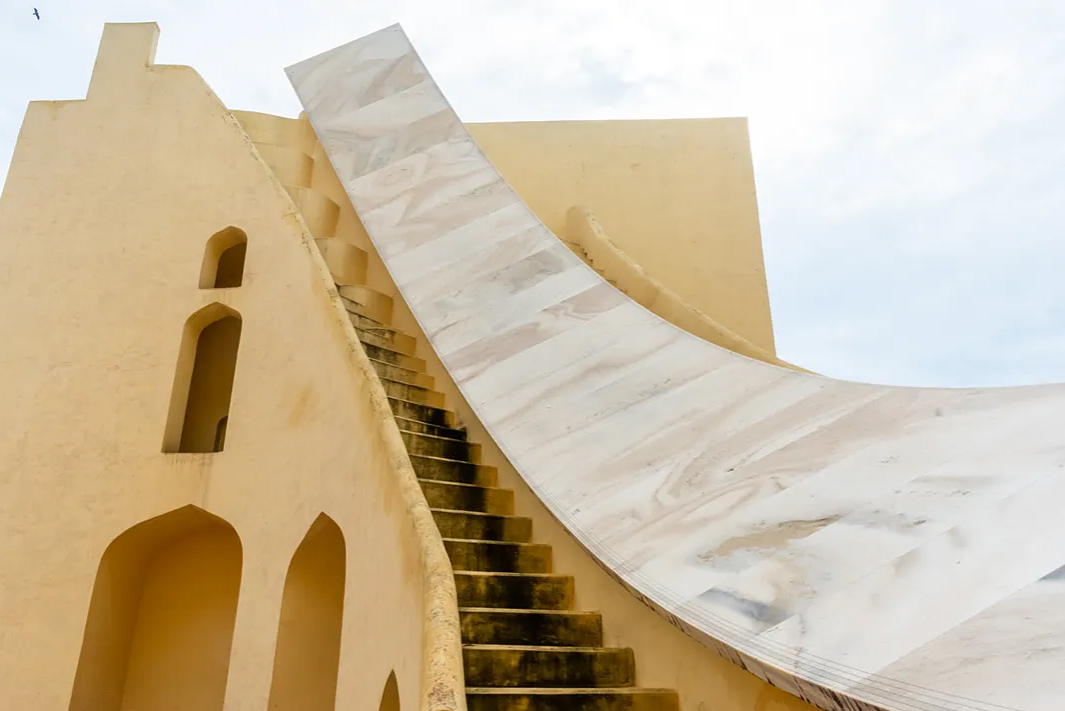 Harita Sistu - Award winning photo of the Equatorial Sundial at Jaipur, India
Harita Sistu - Award winning photo of the Equatorial Sundial at Jaipur, India
Indiana French Dial Found
- Details
- Hits: 7652
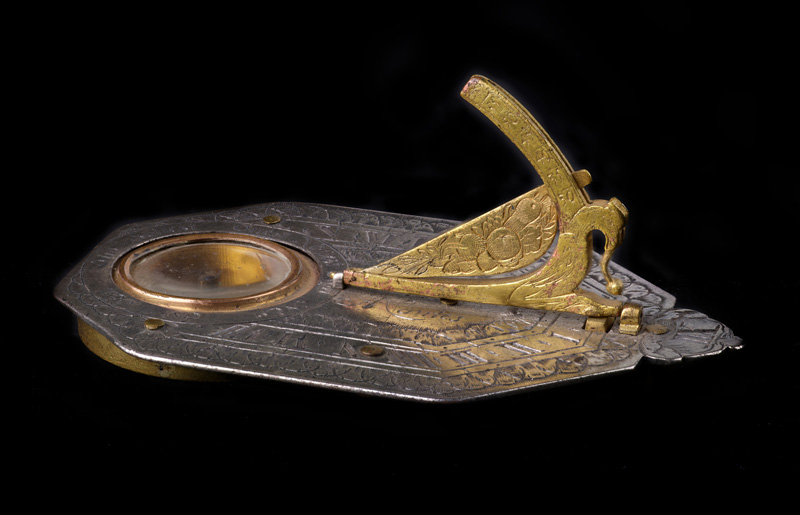 Smithsonian Collection - Pocket sundial by Bourgaud of Nantes, 1660–1675. (MA.325565) Smithsonian Collection - Pocket sundial by Bourgaud of Nantes, 1660–1675. (MA.325565) |
From the National Museum of American History is an article about "How did a French pocket sundial end up buried in a field in Indiana?" published 20 July 2022 by Kidwell & Schechner.
It started in 1860 when Dr. Elisha Cannon, while plowing a field in Indiana, came across a strange object. It was a French Butterfield sundial. It ended up in the Smithsonian collection 100 years later, where it quietly sat until recently when curator Peggy Kidwell wanted to learn more. She contacted Dr. Sara Schechner, David P. Wheatland Curator of the Collection of Historical Scientific Instruments at Harvard University, to join the investigation.
The dial is inscribed "Bourgaud Nantes" showing it was from the workshop of a clockmaker in Nantes, France. As with all Butterfield dials it contained a magnetic compass with declination corrections for orienting the dial to north and a miniature plumb bob to hold the dial level. The gnomon support is in the traditional shape of a bird allowing the gnomon itself to be adjusted to a range of latitudes. Look closely at the chapter ring of hour marks in Roman numerals. Outside the numerals is one hour line scale and on the inside of the numerals is a second scale. The user could approximate the time between these two scales, done for the extreme latitudes 30 and 55 degrees.
"In her research on sundials in the American colonies, Schechner has drawn attention to several of these dials, and notes that some 18th-century French sundial makers, like Pierre le Maire (and his son of the same name), made pocket dials that carefully listed the latitude of places of French interest in both North and South America." How did the dial end up in Indiana? It could have been carried there by Dr. Cannon and his wife Gulielma, Quakers who in 1840 left North Carolina, finding that "living in a state where African Americans were legally enslaved was intorable." Or the dial may have been left a century earlier when the French occupied much of what is now Indiana, leaving outposts such as Terre Haute and possibly a lost sundial.
Read the article: https://americanhistory.si.edu/blog/pocket-sundial

